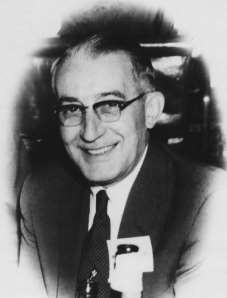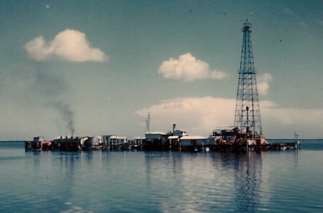Breadcrumb
- Home
- About
- Iowa Geode Stars
- Max Littlefield
Max Littlefield (1900-1967)

Max Sylvan Littlefield was born to Fred Everett and Mary Grace (Stedman) Littlefield on July 1, 1900, on a farm near Cherokee, Iowa. His academic career began at Buena Vista College in Storm Lake, Iowa, in 1917. During 1918, he joined the Student Army Training Corps, but after a short bout with the Spanish flu, he was mustered out. In 1919, he transferred to the University of Iowa, hitchhiking across the state. He received a BA in chemistry in 1921, but found his true calling to be in geology, and began graduate studies.
Initially, he was a student of Chester K. Wentworth (of grain size fame), who taught him sedimentology, but he came to the attention of A. C. Trowbridge. Trowbridge took him on as an assistant, and took him along to help work on the lower Mississippi delta. Littlefield’s report on the bay muds was accepted for his master’s thesis in 1923.
Trowbridge commented: “Being an independent and original worker, he required little help. In his time here (Iowa City), sedimentology and especially laboratory analysis was in its beginnings.”
Littlefield continued with graduate studies at Iowa, working summers for the Illinois State Geological Survey. In 1925 he completed a study on the molding-sand resources of the state, which was accepted at Iowa in lieu of a dissertation for his PhD.
During this time, Littlefield roomed with Walter V. Searight, who later became the Principal Geologist with the Missouri Geological Survey. Littlefield married Searight’s sister Lorraine in 1923.
In 1927, Littlefield went to work for Gypsy Oil Company of Tulsa, a subsidiary of Gulf Oil Corporation. Much of his early work was on the physical properties of oil-field rocks in the Midcontinent, and he did a lot of field geology in the area. During this time, a daughter, Mary Jo, was born, and two sons, Donald (who died in infancy) and Larry, who eventually followed his father into geology.
In his early work, Littlefield recognized the cyclic nature of the Pennsylvanian rocks of northeastern Oklahoma. In May of 1931, he wrote a company report, “Report on Progress on Pennsylvanian Correlation in Oklahoma.” This followed a meeting of geologists in May, 1930, in Urbana, Illinois, where J. M. Weller and others discussed cyclothems. Littlefield recognized a cyclothem with 9 members in Oklahoma, and promoted them as a method of correlation and understanding deposition. His method for logging cyclical sediments became part of his methodology throughout his career.

During the following years, Littlefield’s abilities with surface geology and well operations took him progressively farther from Tulsa. He was sent to Alberta and the northern Rocky Mountains with the discovery of oil in the Mississippian carbonates, and applied his understanding of sequences to them.
During this time, a young Larry Sloss was teaching at the Montana School of Mines and working during the summer for the Montana Bureau of Mines. He wound up doing contract work for Max Littlefield, learning about carbonate and evaporite cycles.
“Decades ahead of the rest of us, Max demonstrated the existence of cycles of many scales, from minicycles observed in outcrop and core to individual cycles (such as those indicated here) revealed by drill cuttings, to successions of similar cycles representing several hundreds of feet of Paleozoic deposition.
“Today, we refer to much that Max described as ‘parasequences’ and ‘parasequence sets’ and we are asked to apply a complex terminology.
“But have we really advanced all that far beyond the frontier exposed to us by Max Littlefield?” (L. L. Sloss, 1996)
In other words, there is a direct line from the ideas of Max Littlefield to Larry Sloss to Pete Vail and Exxon sequence stratigraphy.
Sloss also noted that Littlefield’s ideas impacted evaporite deposition as well as carbonates, calling him “the largely unacknowledged master of carbonate-evaporite sample studies, who taught the art and science of tracing evaporite cycles both laterally and vertically” (L. L. Sloss, 1969, p. 776).
Littlefield’s career continued to be focused on carbonates, and increasingly he was called on by Gulf to travel the world to work on problem carbonate wells and fields. In 1947, he was sent to Venezuela to work with Gulf’s Mara discovery in Cretaceous carbonates (before then, all oil in Venezuela came from Tertiary clastics). During that time, he met a young geologist, William Furnish, working for Creole Petroleum (Standard of New Jersey).
In 1950, Littlefield went to Cuba to work on a well being drilled offshore in shallow water off the northern coast of Cuba. The well was expected to be entirely carbonate, although the prolific seeps and shallow discoveries in the region were all in serpentinite interleaved with the carbonates.
Littlefield also worked on the Ragusa oil field of Sicily, which was the largest field in western Europe until the discoveries in the North Sea.

Near the end of his career, Littlefield spent time in Libya, then advising a Gulf affiliate in Spain with a drilling program in the Basque country of northern Spain. The program was only marginally successful, discovering a gas flow from fractured Cretaceous shales near Vitoria, but it was enough for the Spanish partner to ask Littlefield to come back after his retirement from Gulf in 1961.
Max Littlefield passed on December 24, 1967.
“Max Littlefield made his mark by precept and example in the training of associates, by hard-nosed pursuit of critical data, and by the preparation of proprietary reports that combined scientific insight with oil patch savvy.
“As noted in another AAPG context, ‘some of his contemporaries do not consider him to have been a warm, cuddly and lovable individual, but Max was the guy who checked out cliffy mountain exposures with a binocular microscope hanging around his neck; he was attuned to running samples after midnight and to describing the contents of core boxes laid out in near-zero temperatures.
“Those accustomed to regular hours for food and sleep may have found it difficult to adjust to his work habits, but I and many others found him to be a delightful companion and an inspiring teacher.” (L. L. Sloss, 1996)
The Max and Lorraine Littlefield Geology Fund was set up to support field studies by MS and PhD students in geology at the University of Iowa.
In His Own Words
- Littlefield, M. S., 1923, Bay muds at the mouth of the Mississippi River: Corps of Engineers report accepted in lieu of thesis, Univ. Iowa, 1923.
- Littlefield, M. S., 1925, Natural-bonded molding sand resources of Illinois: Ill. St. Geol. Survey, Bull. 50, 183 p. Accepted in lieu of dissertation, Univ. Iowa, 1925.
- Littlefield, M. S., 1935, Geological note – Log of wildcat well in Pennington County, South Dakota: Amer. Assoc. Petro. Geol., Bull., v. 23, p. 1234-1237.
- Littlefield, M. S., 1927, Mississippi gravels below the mouth of Arkansas River (abs.): Geol. Soc. Amer., Bull., v. 38, p. 147.
- Littlefield, M. S., Gray, L. L., and Godbold, A. C., 1948, A reservoir study of the West Edmond Hunton pool, Oklahoma: Paper No. SPE-948131-G, Trans., v.174, n. 1, p. 131-164.
References
- Sloss, L. L., 1969, Evaporite deposition from layered solutions: Amer. Assoc. Petro. Geol., Bull., v. 53, p. 776-789.
- Sloss, L. L., 1996, Max was a pioneer stratigrapher: Amer. Assoc. Petro. Geol., Explorer, v. 17, n. 11, p. 56-58.
- Biographical information from Larry Littleton